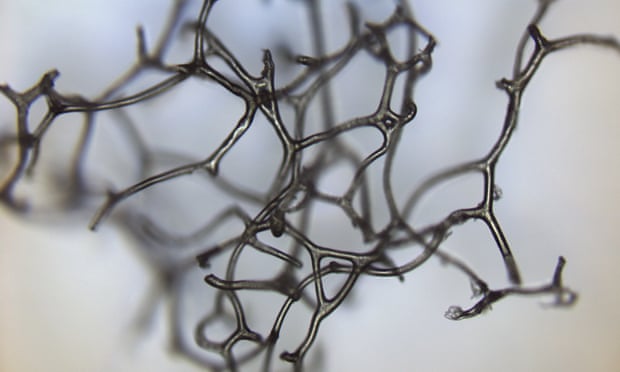Scientists believe the unusual tubular structures may be the remnants of prehistoric sponges
Source: The Guardian
Intricate patterns of tubular structures discovered in giant ancient reefs may be the remnants of prehistoric horny sponges and the oldest known fossils of animal life on Earth.
Researchers found the unusual features in vast reefs that were built by bacteria 890m years ago and then pushed up by geological processes to form part of the Mackenzie Mountains in north-western Canada.
Examined under a microscope, a small number of rock samples revealed tubules about half the width of a human hair that branch and reconnect to form 3D structures that are strikingly similar to those seen in fossils of bath sponges.
“Initially, when you look at these features they look like a bunch of wiggles, but when you try to follow each of the strands, you realise that even in thin sections they form complicated 3D meshworks,” said Prof Elizabeth Turner, at Laurentian University in Sudbury, Ontario.

“Thanks to the wonderful work of others, younger examples of the same microstructures have been found in sponge body fossils and these structures have been compared to the skeletons of a variety of keratose, or horny, sponges,” she added.
While modern reefs are built by corals and algae, in Earth’s distant past communities of photosynthetic cyanobacteria created enormous carbonate reefs measuring many kilometres wide and hundreds of metres thick.
Prof Turner first spotted the weird tubules in a handful of thin sections of rock she gathered as a PhD student during field work at the site. Two decades on, she has built up the collection and discovered more examples of the features in the rocks.
Writing in the journal Nature, Turner describes how the fossils may have formed when putative sponges, measuring a few millimetres to a centimetre across, became mineralised. The soft tissue is first to fossilise, encasing the 3D network of collagen-like fibres that form the sponge’s skeleton. Over time, these skeletal fibres decay, leaving hollow tubules that fill up with calcite crystals.
If the structures are confirmed as early sponge fossils, they would predate the next-oldest undisputed sponge fossils by about 350m years.
According to previous studies, sponges are some of the earliest animals on Earth and emerged during the early Neoproterozoic era one billion to half a billion years ago. However, the exact timing is uncertain. Other research suggests that oxygen levels were too low for animals to thrive until they rose in the Neoproterozoic Oxygenation Event between 800m and 540m years ago.
But even on an oxygen-starved Earth, early sponges may have found a way to survive in the nooks and crannies of microbial reefs if the photosynthetic bacteria that smothered the reefs released enough oxygen into the water. “These possible sponges, or whatever they were, were living in a reef that was an oxygen factory, it was nirvana,” said Prof Turner. For food, they could have consumed the polysaccharide slime that sloughed off the microbial mats into the surrounding ocean.
“If I’m right about the interpretation of this material, then the earliest animals may not have had the same oxygen requirements that we have assumed so far. It’s possible that we had early sponges emerge some time ago, and certainly by 890m years ago, living in a comparatively low oxygen world, but the more complicated animals had to wait a while,” she added.
Far more work is now needed to see whether other rocks of a similar age contain traces of early animal life. “We have to approach it with a much more open mind,” said Prof Turner. “We have to think about what we should expect from early animals. Anything we think of as animal may be too complicated. We want to look for something that expresses the essence of animals, without being too conspicuously familiar.”
Source: The Guardian

































Leave a Comment
You must be logged in to post a comment.